 The grounds were laid out by Charles S. Bell, a Scotsman and horticulturist whose goal it was to create a park-like, landscaped cemetery. Bell – known as a perfectionist, would not open the cemetery until the grounds were finished. The first burial took place on October 2, 1849, when A.B. Colwell, a community businessman who had died of cholera, was laid to rest with his infant son.
The grounds were laid out by Charles S. Bell, a Scotsman and horticulturist whose goal it was to create a park-like, landscaped cemetery. Bell – known as a perfectionist, would not open the cemetery until the grounds were finished. The first burial took place on October 2, 1849, when A.B. Colwell, a community businessman who had died of cholera, was laid to rest with his infant son. The Elkhorn Vale
 |
| Walt Whitman |
A few months ago I spoke with my good buddy PJWB about documenting some of my occasional travels outside of the courthouse collecting that I usually post about. After all, we wanted this site to have as much information about Kentucky as possible. So it seemed like it was high time for that thing that PJWB loves: a BRAND NEW HASHTAG!
From here on out, I (NRK) will post on travels not relating to courthouses using the #ElkhornVale tag.
The term comes from Leaves of Grass, Whitman’s famous poem. In context, Whitman was accounting for his one-ness with others of this nation – in his own perhaps overly romantic way. Here is a portion the passage:
I am of old and young, of the foolish as much as the wise,
Regardless of others, ever regardful of others,
Maternal as well as paternal, a child as well as a man,
Stuff’d with the stuff that is coarse and stuff’d with the stuff
that is fine,
One of the Nation of many nations, the smallest the same
and the largest the same,
A Southerner soon as a Northerner, a planter nonchalant
and hospitable down by the Oconee I live,
A Yankee bound my own way ready for trade, my joints the
limberest joints on earth and the sternest joints on earth,
A Kentuckian walking the vale of the Elkhorn in my deer-skin
leggings, a Louisianian or Georgian,
A boatman over lakes or bays or along coasts, a Hoosier,
Badger, Buckeye . . .– Walt Whitman, Leaves of Grass.
Anyway, I hope to provide some interesting content over the next few weeks.
kernel: Dominicans vs. the Pros
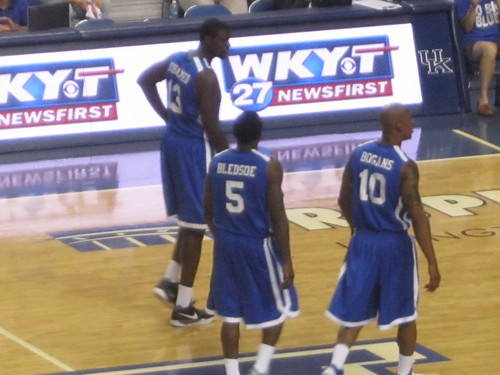 |
| Nazr Mohammed, Eric Bledsoe and Keith Bogans at Rupp Arena – Lexington, Ky. |
Last night at Rupp Arena, the John Calipari-led Dominican Republic (DR) national team soundly defeated a corps of NBA professional, former-Kentucky Wildcats coached by Joe B. Hall.
Yes, last night was a Kentucky fan’s dream come true. On the floor were Nazr Mohammed, Tayshaun Prince, and Keith Bogans. And Jodie Meeks. And John Wall, Demarcus Cousins, and Eric Bledsoe. All coached by a Harrison County native who, at age 82 and after 26 years of retirement, coached one more game.
The DR national team was stocked with talent, including a few NBA greats. And one Eloy Vargas, still a UK player, who fans demanded be played by Coach Cal. Coach Cal complied with a minute to spare.
In the end, the score didn’t matter (DR won, 106-88). It was a packed house at Rupp Arena for a Caribbean nation’s exhibition game. It provided some much-needed relief from the annual abyss when sports fans are left abandoned by their football and basketball passions.
Yeah, it was an awesome night. Just look at the picture: Nazr Mohammed (95-98), Eric Bledsoe (09-10) and Keith Bogans (99-03). Generations of Kentucky players on the court at once respectively representing the Rick Pitino, John Calipari, and Tubby Smith eras. Three players, all wearing the blue and white, being coached by Joe B. Hall. Yes – it was an awesome night! You can check out the rest of the pictures I took on flickr.
NoD: Lexington’s New Interchange
This morning, I navigated the new double-diamond interchange (DDI) at Harrodsburg Road and New Circle. For a few seconds, I was a British-subject driving on the left side of the road. The concept of this design, first engineered in 2003, became a reality on U.S. roads in 2009 at Springfield, Missouri. Lexington’s DDI is the sixth such interchange in North America.
This post was republished on KYforward.com on August 17, 2011.
walkLEX: Preservation Along East Third Street
The Bluegrass Trust for Historic Preservation hosts a monthly deTour to a local historic site that has been well-preserved and restored. Please join us on our next deTour – details on Facebook! Our guides for the East Third Street deTour were property owners and preservationists John Morgan and Linda Carroll. The deTour also included a stop at Atomic Cafe and the Morgan-Carroll residence, both of which will be profiled later.
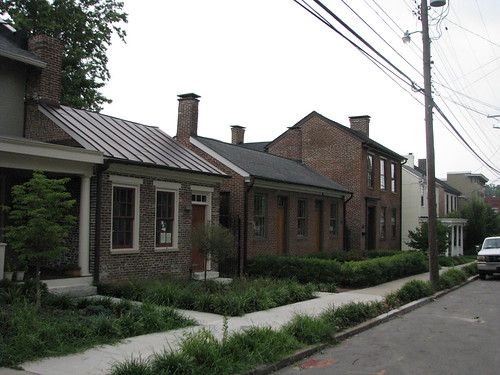 |
| East Third Street – Lexington, Ky. |
Across East Third Street from the Carrick House are a number of older properties in various stages of (dis)repair. John Morgan and Linda Carroll, owners of three of these properties, have taken my grandfather’s sage advice in Lexington’s quest of historic preservation: “one bite at a time.” There three buildings – 146, 126, and 122 East Third Street – are, in that order, increasingly well-preserved yet adapted for today’s use.
Painstaking efforts to maintain the streetscape appearance and to enlarge and modernize interior facilities while preserving interior features that can be preserved seem to be hallmarks of the Morgan/Carroll brand. The three properties each have a unique history and are fantastic examples of preservation and adaptive reuse.
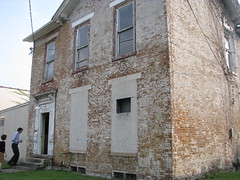 |
| 146 East Third Street – Lexington, Ky. |
Walking into 146 is like walking into a true construction zone. Originally built in 1847, this property was sold in 1849 to Daniel Wickliffe, the editor of the Lexington Observer and Reporter. Wickliffe would later serve as the Secretary of State under Governor Robinson. In the mid-1900s, the property was a Moose Lodge and was later converted into apartments. Morgan & Carroll acquired this property in late 2009 and have not yet begun restoration, so many remnants of its days as a tenement remain. Additional pictures of 146 East Third Street are available here.
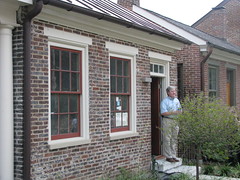 |
| John Morgan welcoming us to 126 East Third Street – Lexington, Ky. |
At 126, the work is almost complete. Built around 1839, the small residence was a rental for much of its life. In September 1925, the tenant was John Morys, a jockey who rode Frogtown to a second-to-last finish in the 1919 Kentucky Derby; it was in the house that he took his own life by ingesting carbolic acid. The exterior has been restored and the interior is framed. As mentioned above, historical details (moulding, etc) that can be preserved is, but the Morgan/Carroll brand is to modernize the interior making it comfortable for 21st century living. The property was greatly expanded by Morgan and Carroll, who purchased the property in 2004 to preserve the integrity of the neighborhood where they live and work. Atop the addition will be a green roof and roof patio that will greatly expand the home’s living area while not disrupting the appearance from the street of this side-gabled, three-bay. Additional pictures of 126 East Third Street are available here.
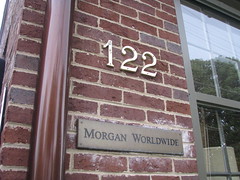 |
| 122 East Third Street – Lexington, Ky. |
122 serves as the headquarters for Morgan Worldwide and is the completed structure in the trio. Built in 1839, the building was restored in 1998. During the restoration, the basement was discovered and was dug out by hand having been completely filled with dirt – it was discovered by a keen eye noting the peculiarity of the top of a door frame being at ground level. In 1906, Professor Bernard Grehan passed from this life; his funeral was held in this house which was then owned by his daughter, Mrs Lillie Clark. Grehan was an Irishman whose accolades ranged from the ministry to mathematics and from trading to teaching; his son, Enoch Grehan, would help establish the journalism school at the University of Kentucky and the University’s journalism building would bear his name. Additional pictures of 122 East Third Street are available here.
These are three gems in Lexington’s Constitution Historic District – one that, like so many of Lexington’s historic neighborhoods – has a colorful past and, with the help of individuals like Morgan and Carroll, a bright future
Bibliography
Connelley’s History of Kentucky (v. 4), p.106-107.
Fayette PVA
local.lexpublib.org
kernel: Storm Clouds
Yes. I’ve been awful about getting stuff posted on here. Real life has been really busy, but I’ll try harder. In the meantime, check out these pre-storm pictures from last week in Lexington. Eerie!
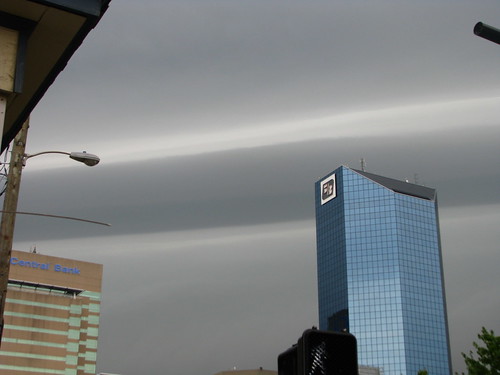 |
NoD: West Liberty’s Millstone Monument
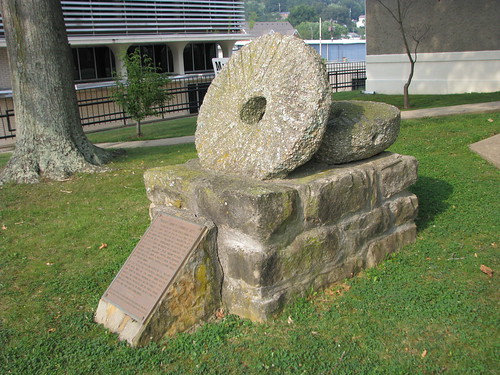 |
| Millstone Monument – West Liberty, Ky. |
On the Morgan County courthouse lawn in West Liberty rests a most peculiar, yet appropriate, monument. So many communities in Kentucky, across America and around the world began where a stream provided the power to turn the mechanisms of a gristmill – turning crops into flour.
The owner of the mill, a millwright, would convert a farmer’s crop to flour and would keep for himself some of the end product – a miller’s toll. Around these mills, other forms of commerce would develop creating many of the towns we know today. Of course, most of the mills are long gone. But Morgan County has preserved this token of history with a courthouse lawn monument to the millstone.
In 1816, Edmund Wells established his grist mill on the Licking River. This grist mill quickly grew in importance for the area’s farmers, and the “Wells Mill” community quickly grew as all roads in the area found Wells Mill as their focal point. To account for his travelers, Wells also owned and operated a tavern in Wells Mill. In 1822, the General Assembly created Morgan County from Floyd and Bath counties; on March 10, 1823 the justices of the newly formed Morgan County, including Wells, met at Wells’ tavern to make effective the establishment of Morgan County. The time and place of this meeting was set forth in the Act establishing the county.
West Liberty was established as the county seat upon 39 acres donated by Edmund Wells. He donated an additional two acres for the public square whereupon he was contracted to build the county’s first jail and courthouse.
The millstones used in this monument were not, however, from Wells’ mill. Instead, they were from the mill of Capt. John T. Williams who served in the Confederate army during the Civil War. After the war, Williams established his own mill on the Big Caney Creek in Morgan County. In 1869, however, Elliott County was formed and the Big Caney Creek is wholly within the bounds of Elliott County.
Capt. Williams’ links to Morgan County and to Edmund Wells, however, are strong. Williams’ father was squire John T. Williams who, like Edmund Wells, was appointed by Governor Adair in 1822 as one of the first justices of Morgan County. Capt. Williams’ father was present at Wells’ tavern on March 10, 1823, and it is his son’s millstones that forever memorialize the import of the mill in Morgan County’s history.
Bibliography
“Acts of the Kentucky General Assembly”, 1823, pages 145-147 [*]
Ancestors of Squire John T. Williams
Kentucky Encyclopedia, “Morgan County“
Plaque at the Millstone Monument
NoD: Judge John E. Cooper House
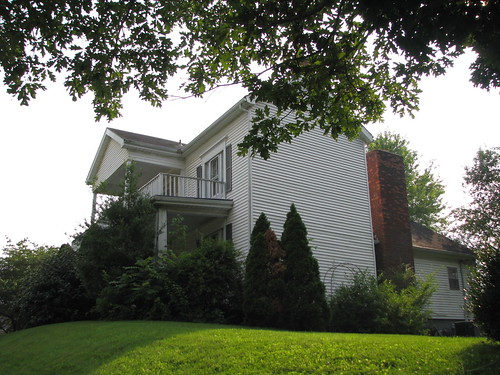 |
| Judge John E. Cooper House – West Liberty, Ky. |
On Main Street, at the northern edge of Morgan County’s seat, stands the Judge John E. Cooper House – the oldest extant house in West Liberty. Built in 1872/73, this two-story frame structure assumes no formal architectural design, but is representative of much of eastern Kentucky’s mid-19th century architecture with one notable exception. The entire house was completed in one construction effort – this rapid build and the scale of the project would have made it a most-impressive structure for Morgan County in the 1870s. The National Register profile for the house makes careful note of this feat, pointing out that it would have been considered symbolic of Cooper’s power and prestige, without being showy.
Judge Cooper was a powerful figure in regional politics and law. In the Civil War, he and his fellow Morgan countians sympathized with the Confederacy and took up arms for her; he was wounded at the Battle of Ivy Monutain (Floyd County) in November 1861. He attended law school and graduated from the A&M College at Kentucky University before returning to Morgan County. There, he married and practiced law before becoming county attorney and, later, state senator. Col. John Thomas Hazelrigg spoke well of the senator during his centennial address in 1876, saying that Cooper was “full of hope and promise, now engaged in the practice of his profession as a lawyer, and is distinguished for his zeal and energy with which he represents the interests of his clients. Although young in years, he has taken a front rank in his profession and bids fair to enroll his name among the first jurists of the Commonwealth.”
Cooper did not disappoint Hazelrigg. In 1883, Cooper was nominated to fill a vacancy on the circuit court. He was repeatedly elected to the position and held the office for 22 years, “longer than any other man.” Of Judge Cooper, Judge Edward C. O’Rear (Ky. Ct. Appeals) wrote: “He was a vigorous executive and worked as hard on the bench for the whole term of his service as at any time whilst at the bar. He not only adjudged the law in his courts, he administered it. A rugged type, powerful physique, dignified bearing, he gave to each case before him the most painstaking investigation.” Judge O’Rear went on to note that Cooper never wore spectacles, “though he read every paper in every case submitted to him, and every authority cited, and prepared with his own pen the instructions to juries, his orders and judgments.”
It is believed that Cooper designed the house which he continued to own until 1896, though construction was completed by Thomas Jefferson Cassity and his son, Reuben. Cooper, however, was known to have done some architectural planning; the plan and specifications for the third Morgan County courthouse were drafted in 1870 by Morgan. Local legend, though improbable, suggests that Morgan modeled the courthouse after the colonial capitol at Williamsburg, Virginia.
Additional pictures of the Cooper House are available on flickr.
Bibliography
NRHP, “Judge John E. Cooper House“
NRHP, “Morgan County Courthouse”
kernel: “I Pledge Allegiance to the Flag…”
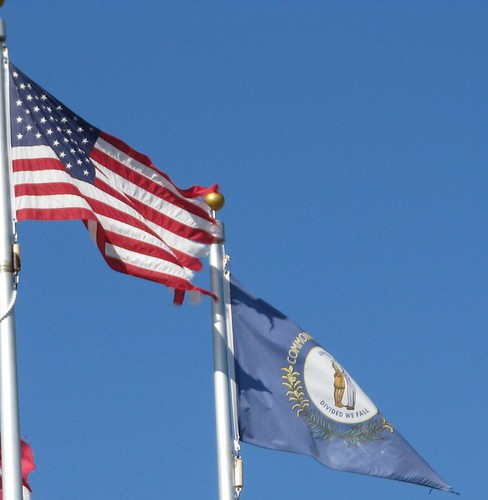 |
| American, Kentucky flags flying at Mill Creek Nat’l Cemetery |
We all remember starting off our school days reciting the Pledge of Allegiance to the American flag, but did you know that there is a pledge to Kentucky’s flag as well? Enacted by the state legislature in 2000 as KRS 2.035, the pledge reads:
I pledge allegiance to the Kentucky flag, and to the Sovereign State for which it stands, one Commonwealth, blessed with diversity, natural wealth, beauty, and grace from on High.
NoD: Keith Whitley Tribute in Sandy Hook
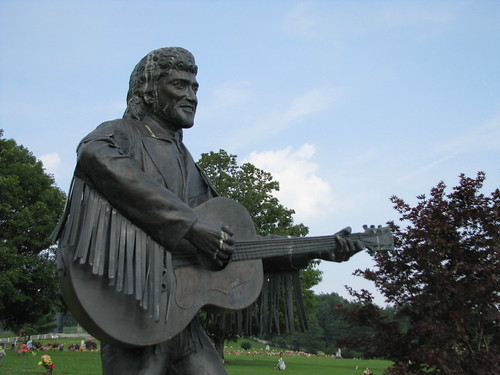 |
| Keith Whitley Tribute – Sandy Hook, Ky. |
ESPN’s Pat Forde described Elliott County as having, despite all its problems, a “surplus of pride.” The same can be said for so many hamlets, burgs, and counties throughout the Commonwealth. Despite the pride, few historic references are visible to the Elliott County visitor. One source of pride, however, is country music star Keith Whitley.
More pictures of the tribute can be found on my flickr account.

